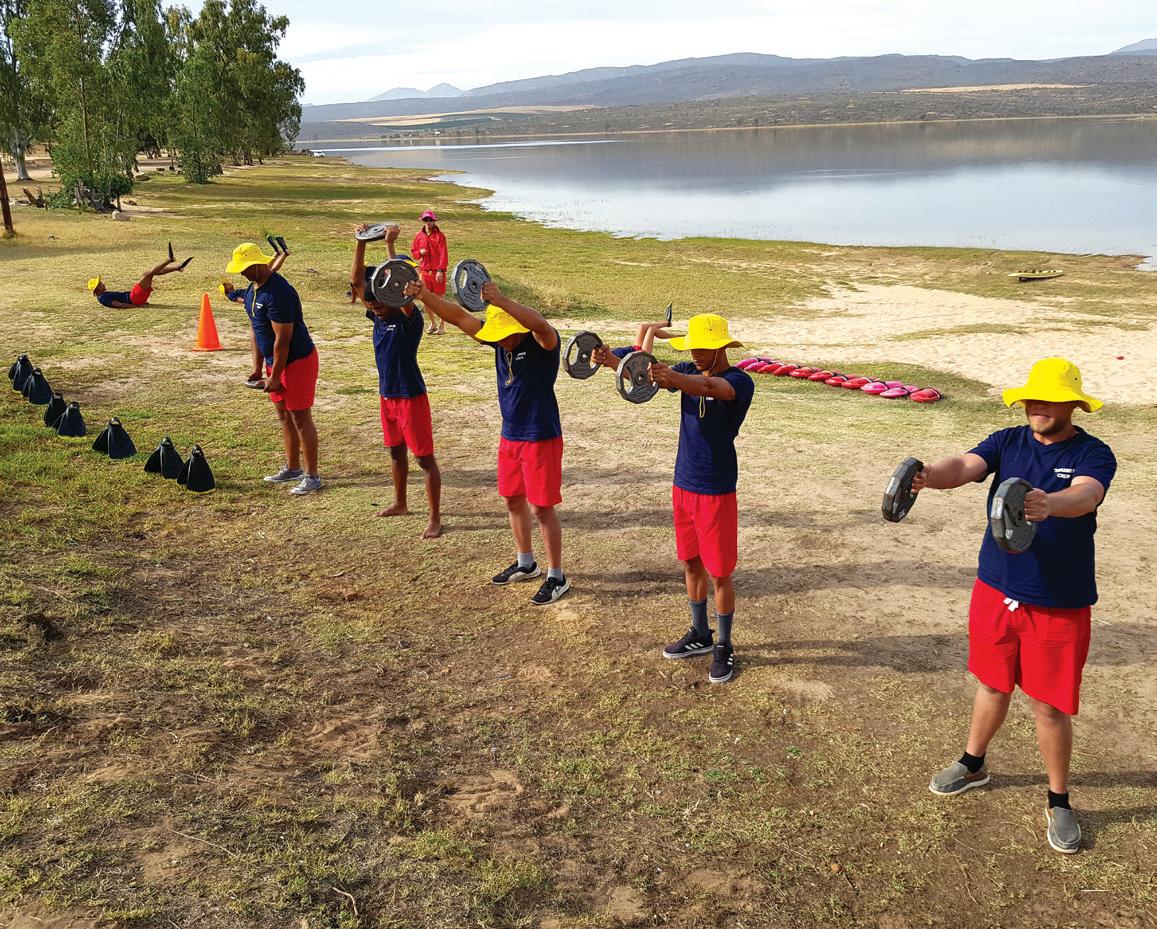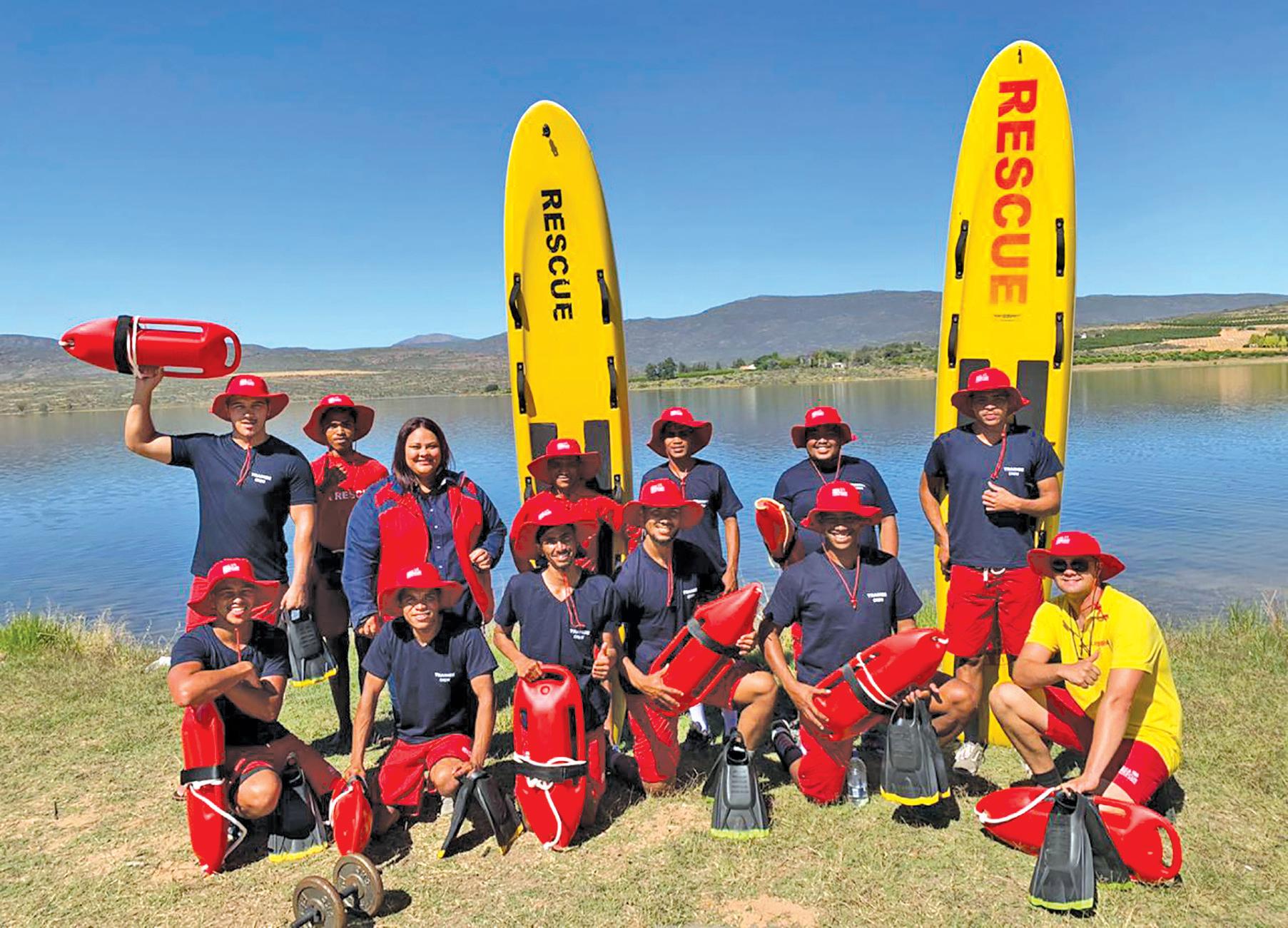
5 minute read
NSRI’S LIFEGUARD UNIT The rollout of the Lifeguard Unit continues, with new lifeguard stations being established at recognised danger hot spots
NSRI’S Ockert van Schalkwyk of Station 45 (Strandfontein, West Coast) watches over the safe swimming area. LIFEGUARD
UNIT THE NSRI LIFEGUARD UNIT was launched in 2017 at Melkbosstrand in Cape Town, where the nearby beaches accounted for 25% of NSRI’s Lifeguard Unit Cape Town’s fatal drownings. It’s a dangerous stretch focuses on prevention and of coastline with no lifeguard infrastructure. NSRI education: by educating Station 18 (Melkbosstrand) frequently responded to drownings. The idea behind launching a lifeguard people and equipping them station was to be able to have a more proactive with knowledge of how best to approach to rescues rather than just reacting. It was react in a dangerous situation envisaged that having highly trained and equipped in water, lives are saved. lifeguards patrolling the beaches would make it By Cherelle Leong possible to react sooner and prevent a situation from becoming critical and life-threatening. Three years on, the NSRI Lifeguard Unit at Melkbostrand is proud to report zero fatal drowning incidents

Left (from left): Hendrey Louw, Jean Gooiman, Anrich Cloete, Ronaldo Taboois and Leon Blignaut performing lifeguard training. Below: The first-of-itskind lifeguard trailer.
under the lifeguards’ watch. Additionally, there are now a total of seven lifeguard stations in South Africa, many in partnership with local municipalities. Station 16 (Strandfontein, Cape Town) launched its lifeguard programme in 2018 with an innovative model. As part of a partnership with the City of Cape Town, it has agreed to train 20 lifeguards from local communities. The area they have to patrol is a long, remote stretch of beach, and historically the majority of drowning incidents happen outside of the designated swimming areas. An all-terrain vehicle is used to patrol the beach and ensure remote monito- ring of some of the most dangerous stretches where there are strong rip currents. Moreover, the lifeguards patrol the coastal waters on a custom-designed JetRIB that has superb operational capability in the surf and can respond to incidents quickly.
In 2018 the Cederberg Municipality, which includes Lambert’s Bay, Elands Bay and the Clanwilliam Dam, was among the municipalities with the highest number of drowning incidents in the Western Cape. Having no lifeguarding infrastructure in place, the municipality approached NSRI, which agreed to assist in setting up stations and training municipal and volunteer lifeguards from the area. The initiative has been a huge success, reporting zero drownings in the first two seasons and the establishment of a strong water-safety team in these areas.
The NSRI Lifeguard Unit is not only saving lives, it’s also changing lives by giving people the opportunity to learn valuable swimming and lifesaving skills and gain employment in the process. By 2019, 91 lifeguards had been trained and certified.
Paul Makupula’s is just one of several lifeguarding success stories. He first got involved

in lifesaving at the age of 22 when he took up an offer for free training by the Kouga Municipality. He was unemployed at the time and saw it as an opportunity to gain skills that could help him secure employment.
Paul is now 31 and has a job but still volunteers at Station 37 (Jeffreys Bay). He has since qualified as crew and earned his SAMSA skipper’s certificate – impressive, considering he was scared of the sea and wasn’t able to swim nine years ago.
As much as the NSRI Lifeguard Unit is proud of all that has been achieved to date, this is only
The new lifeguard recruits for Cederberg complete their training for the 2020/2021 season.
the beginning. Relentlessly pursuing the goal of drowning prevention, it is continuing to innovate. For the 2020 season, NSRI lifeguards will be on standby on an additional five beaches around the country. A joint venture with the City of Cape Town has enabled lifeguards to provide lifeguarding services along the stretches of beach between Tableview and Bloubergstrand that previously had no infrastructure. The SA Red Cross Air Mercy Service has helped by contributing a trailer which the NSRI has branded and fully equipped to operate as a mobile unit to support lifeguards employed by the City of Cape Town in their duties.

Yet perhaps the most exciting innovation is the development of the NSRI rescue swimmer app. While there are many people who have strong swimming skills and spend time on the beach and in the water, they don’t always have the time to volunteer or train as NSRI lifeguards or rescue crew. The app will provide all the theoretical training of lifesaving through instructional videos. This will include instruction on rescuer safety when approaching a casualty, rescue techniques, CPR and basic first aid, as well as basic rescue operation protocols. Rescues are often initiated by bystanders who happen to see an incident take place. The idea behind the app is to equip people to know what to do in an emergency and how to ensure they remain safe while helping others. If bystanders are equipped and knowledgeable, people in trouble in the water can get the help they need much faster.
A lifeguard reporting app will also be used to communicate vital information to rescue
Left: Lifeguards conduct endurance training, ensuring that they never give up until their casualty is safe. Above: Strandfontein, West Coast, lifeguards begin their season with a tribute to late lifeguard Clive Cerff.


authorities, ensuring that medical or rescue personnel know what they’re responding to and can quickly initiate advanced care on scene if it is required. The app records information about all incidents, not just fatal drownings. This also enables NSRI to track the effectiveness of drowning-prevention initiatives.
There are three ways in which you can become involved in NSRI lifeguarding. If you have the right level of fitness and swimming ability, and some free time, you can train as a rescue swimmer. As a certified rescue swimmer you will also have the opportunity to be employed by local municipalities during the summer season. If you do not meet the fitness requirements, you could still become a beach patroller, monitoring the beach and assisting with providing first aid when required. If you don’t have the time available for either of these options, you can use the app to access training and be equipped should a rescue situation ever present itself.








